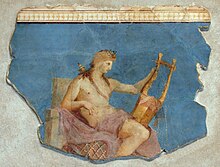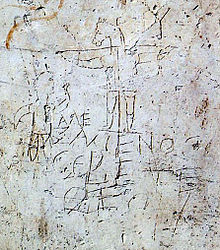Palatine Museum
You can help expand this article with text translated from the corresponding article in Italian. (October 2020) Click [show] for important translation instructions.
|
 Palatine Museum | |
 Click on the map for a fullscreen view | |
| Coordinates | 41°53′20″N 12°29′15″E / 41.88889°N 12.48750°E |
|---|---|
| Type | archaeology |
The Palatine Museum (Italian: Antiquarium del Palatino) is a museum located on the Palatine Hill in Rome. Founded in the second half of the 19th century, it houses sculptures, fragments of frescoes, and archaeological material discovered on the hill.
History

In the 1930s, on the initiative of the archaeologist Alfonso Bartoli, director of excavations on the Palatine and discoverer of numerous objects on the site of the Domus Augustana, a new site was created, using the remaining parts of the demolished Villa Mills.
Bartoli managed to bring back on the Palatine a part of the sculptures from here that were in the Museum of the Baths, which in the meantime became the National Roman Museum, and exhibited them in a building built starting from 1868 for the Visitation nuns above the structures belonging to the ancient imperial palace of
The Antiquarium therefore now exhibits only materials directly linked to the history of the Palatine. The reorganization of the Roman National Museum, following the 1981 law on the archaeological heritage of Rome, leads to the return of the sculptures that have been found to the Antiquarium. The museum was entirely reorganized under the aegis of the Special Superintendence for Archaeological Heritage of Rome to present a panorama of imperial artistic tastes, from Augustus to Late Antiquity.
Since 2016, the Antiquarium belongs to the newly established Colosseum Archaeological Park.[1]
Collections
The building comprises two floors, each consisting of four rooms. The ground floor is dedicated to the Palatine from its origins to the Republican era, while the first floor is dedicated to works from the imperial era.
Ground floor
The rooms from I to III contain stone objects (room I), which attest to a human presence on the Palatine from the Middle Palaeolithic and, continuing, into the Upper Palaeolithic. Traces of a village of huts dating back at least to the eighth century BC have also been found: they consist of vases and other impasto utensils, locally made. Among other things, the rooms also include the models of the huts, the contents of an infantile tomb dated to the beginning of the 7th century BC and a wall that allows the reconstruction of the stratigraphy of hut A, i.e. the various discoveries ordered from the most recent to the most ancient, following the order in which they were found.
In room IV the works of the Archaic and Republican periods are exhibited. Among them is an altar from the Silla period dedicated to "a god or a goddess", a vague formulation found elsewhere and which is probably destined to hide the true name of the revered god from its enemies. There are also several antefixes in polychrome terracotta from various eras, representing Juno Sospita and, perhaps, Jupiter and Apollo.
First floor


In room V, works from the time of
In room VI there are paintings and decorations in opus sectile from the
Rooms VII and VIII group together works from the
There is also the famous
Room IX is a gallery that groups Roman copies of Greek statues, coming from the imperial palaces of the Palatine.
References
- ^ "Museo Palatino". Parco archeologico del Colosseo. Retrieved 1 June 2020..
- ^ Filippo Coarelli, Guida archeologica di Roma, Arnoldo Mondadori Editore, Verona 1984, pag. 158.
- ^ Michael Green, Evangelism in the Early Church, Wm. B. Eerdmans Publishing, 2004, p. 244
- ^ David L. Balch, Carolyn Osiek, Early Christian Families in Context: An Interdisciplinary Dialogue, Wm. B. Eerdmans Publishing, 2003, p. 103
- ^ B. Hudson MacLean, An introduction to Greek epigraphy of the Hellenistic and Roman periods from Alexander the Great down to the reign of Constantine, University of Michigan Press, 2002, p. 208
Bibliography
- Maria Antonietta Tolomei, Museo Palatino, Electa, 1997. ISBN 88-435-6325-4.
